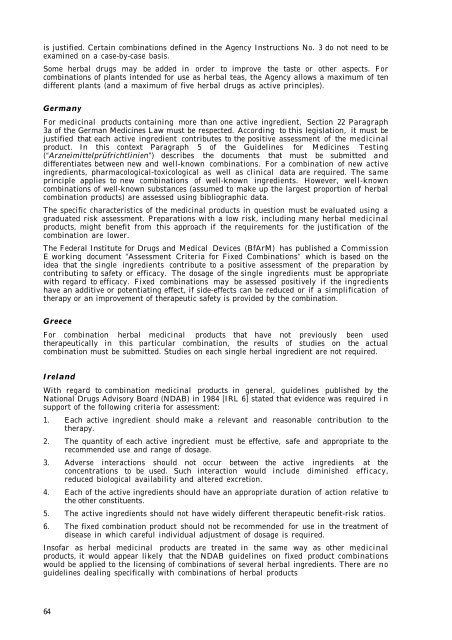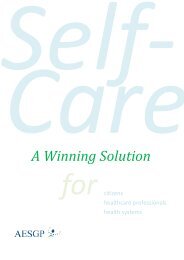Herbal medicinal products in the European Union - AESGP
Herbal medicinal products in the European Union - AESGP
Herbal medicinal products in the European Union - AESGP
You also want an ePaper? Increase the reach of your titles
YUMPU automatically turns print PDFs into web optimized ePapers that Google loves.
is justified. Certa<strong>in</strong> comb<strong>in</strong>ations def<strong>in</strong>ed <strong>in</strong> <strong>the</strong> Agency Instructions No. 3 do not need to be<br />
exam<strong>in</strong>ed on a case-by-case basis.<br />
Some herbal drugs may be added <strong>in</strong> order to improve <strong>the</strong> taste or o<strong>the</strong>r aspects. For<br />
comb<strong>in</strong>ations of plants <strong>in</strong>tended for use as herbal teas, <strong>the</strong> Agency allows a maximum of ten<br />
different plants (and a maximum of five herbal drugs as active pr<strong>in</strong>ciples).<br />
Germany<br />
For <strong>medic<strong>in</strong>al</strong> <strong>products</strong> conta<strong>in</strong><strong>in</strong>g more than one active <strong>in</strong>gredient, Section 22 Paragraph<br />
3a of <strong>the</strong> German Medic<strong>in</strong>es Law must be respected. Accord<strong>in</strong>g to this legislation, it must be<br />
justified that each active <strong>in</strong>gredient contributes to <strong>the</strong> positive assessment of <strong>the</strong> <strong>medic<strong>in</strong>al</strong><br />
product. In this context Paragraph 5 of <strong>the</strong> Guidel<strong>in</strong>es for Medic<strong>in</strong>es Test<strong>in</strong>g<br />
(“Arzneimittelprüfrichtl<strong>in</strong>ien”) describes <strong>the</strong> documents that must be submitted and<br />
differentiates between new and well-known comb<strong>in</strong>ations. For a comb<strong>in</strong>ation of new active<br />
<strong>in</strong>gredients, pharmacological-toxicological as well as cl<strong>in</strong>ical data are required. The same<br />
pr<strong>in</strong>ciple applies to new comb<strong>in</strong>ations of well-known <strong>in</strong>gredients. However, well-known<br />
comb<strong>in</strong>ations of well-known substances (assumed to make up <strong>the</strong> largest proportion of herbal<br />
comb<strong>in</strong>ation <strong>products</strong>) are assessed us<strong>in</strong>g bibliographic data.<br />
The specific characteristics of <strong>the</strong> <strong>medic<strong>in</strong>al</strong> <strong>products</strong> <strong>in</strong> question must be evaluated us<strong>in</strong>g a<br />
graduated risk assessment. Preparations with a low risk, <strong>in</strong>clud<strong>in</strong>g many herbal <strong>medic<strong>in</strong>al</strong><br />
<strong>products</strong>, might benefit from this approach if <strong>the</strong> requirements for <strong>the</strong> justification of <strong>the</strong><br />
comb<strong>in</strong>ation are lower.<br />
The Federal Institute for Drugs and Medical Devices (BfArM) has published a Commission<br />
E work<strong>in</strong>g document “Assessment Criteria for Fixed Comb<strong>in</strong>ations” which is based on <strong>the</strong><br />
idea that <strong>the</strong> s<strong>in</strong>gle <strong>in</strong>gredients contribute to a positive assessment of <strong>the</strong> preparation by<br />
contribut<strong>in</strong>g to safety or efficacy. The dosage of <strong>the</strong> s<strong>in</strong>gle <strong>in</strong>gredients must be appropriate<br />
with regard to efficacy. Fixed comb<strong>in</strong>ations may be assessed positively if <strong>the</strong> <strong>in</strong>gredients<br />
have an additive or potentiat<strong>in</strong>g effect, if side-effects can be reduced or if a simplification of<br />
<strong>the</strong>rapy or an improvement of <strong>the</strong>rapeutic safety is provided by <strong>the</strong> comb<strong>in</strong>ation.<br />
Greece<br />
For comb<strong>in</strong>ation herbal <strong>medic<strong>in</strong>al</strong> <strong>products</strong> that have not previously been used<br />
<strong>the</strong>rapeutically <strong>in</strong> this particular comb<strong>in</strong>ation, <strong>the</strong> results of studies on <strong>the</strong> actual<br />
comb<strong>in</strong>ation must be submitted. Studies on each s<strong>in</strong>gle herbal <strong>in</strong>gredient are not required.<br />
Ireland<br />
With regard to comb<strong>in</strong>ation <strong>medic<strong>in</strong>al</strong> <strong>products</strong> <strong>in</strong> general, guidel<strong>in</strong>es published by <strong>the</strong><br />
National Drugs Advisory Board (NDAB) <strong>in</strong> 1984 [IRL 6] stated that evidence was required i n<br />
support of <strong>the</strong> follow<strong>in</strong>g criteria for assessment:<br />
1. Each active <strong>in</strong>gredient should make a relevant and reasonable contribution to <strong>the</strong><br />
<strong>the</strong>rapy.<br />
2. The quantity of each active <strong>in</strong>gredient must be effective, safe and appropriate to <strong>the</strong><br />
recommended use and range of dosage.<br />
3. Adverse <strong>in</strong>teractions should not occur between <strong>the</strong> active <strong>in</strong>gredients at <strong>the</strong><br />
concentrations to be used. Such <strong>in</strong>teraction would <strong>in</strong>clude dim<strong>in</strong>ished<br />
reduced biological availability and altered excretion.<br />
efficacy,<br />
4. Each of <strong>the</strong> active <strong>in</strong>gredients should have an appropriate duration of action relative to<br />
<strong>the</strong> o<strong>the</strong>r constituents.<br />
5. The active <strong>in</strong>gredients should not have widely different <strong>the</strong>rapeutic benefit-risk ratios.<br />
6. The fixed comb<strong>in</strong>ation product should not be recommended for use <strong>in</strong> <strong>the</strong> treatment of<br />
disease <strong>in</strong> which careful <strong>in</strong>dividual adjustment of dosage is required.<br />
Insofar as herbal <strong>medic<strong>in</strong>al</strong> <strong>products</strong> are treated <strong>in</strong> <strong>the</strong> same way as o<strong>the</strong>r <strong>medic<strong>in</strong>al</strong><br />
<strong>products</strong>, it would appear likely that <strong>the</strong> NDAB guidel<strong>in</strong>es on fixed product comb<strong>in</strong>ations<br />
would be applied to <strong>the</strong> licens<strong>in</strong>g of comb<strong>in</strong>ations of several herbal <strong>in</strong>gredients. There are no<br />
guidel<strong>in</strong>es deal<strong>in</strong>g specifically with comb<strong>in</strong>ations of herbal <strong>products</strong><br />
64




